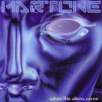Hello readers. Welcome again to another installment of Zone Recording. This month I will be discussing project drum miking techniques. The following photographs and mp3 samples are from a new Martone song which will be on the next album (no release date set yet).
We have been doing drums at Brainwork's Studio (my home project studio for the last 4 songs). We had the chance to go into a great studio, but we decided that we liked the "vibe" of Brainwork's, so we stuck with the home studio.
This will be a basic lesson on drum mic choice and placement with some audio samples. Please realize that all sounds you will hear have basically no equalization or dynamics on them. They are pretty much straight to hard disk, with the exception of a little compression and limiting to get good recording levels.
First off, the drummer's kit consisted of:
1 kick drum
1 snare drum
1 hi-hat
1 ride
4 or 5 crash cymbals
3 toms
Seems easy enough. Yeah right!
Here is a picture of the whole kit.
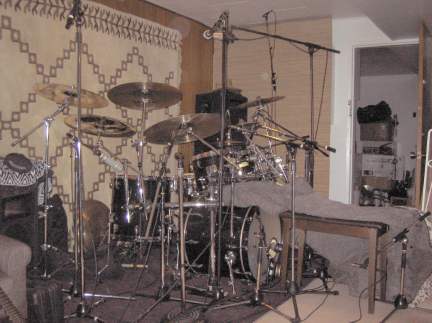
First, we started with the bass drum. We used 4 mikes on the bass drum. An AKG D112 was placed right in the hole of the kick drum on the back of the kick head. A Rodes NT5 condenser was placed approx 2 1/2 feet back from the back head of the kick. A Shure SM 57 was placed on the front of the head, right where the beater strikes the drum.
Next is the secret weapon for awesome low end. It is a Yamaha NS10 woofer placed on a mic stand and wired up to an XLR cable. OK, you are all saying, "What the hell is that?" Well, that thing acts as a mic when you plug it in, giving you insane bass!
You will notice I also built a kick sound tube out of a piano bench covered with my old bedspread cover.
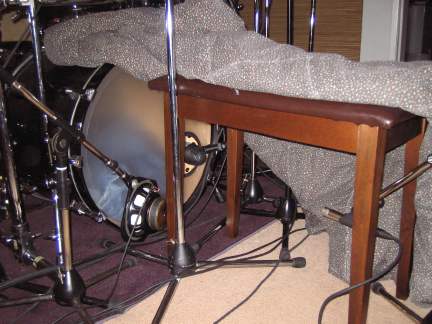
Rear kick head
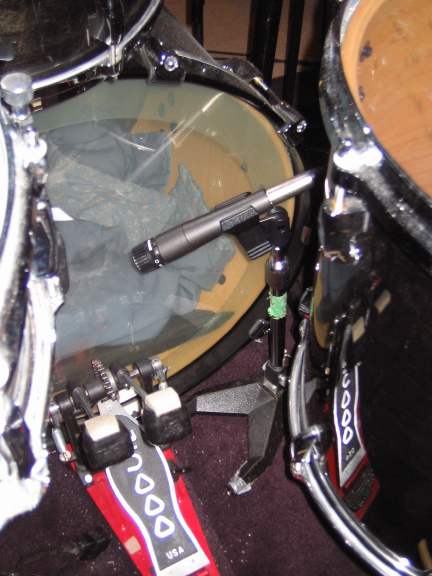
Front kick head
The kick is the backbone of the music. It has to be just right.
MP3 - The NS10 gives the low end.
MP3 - The SM 57 gives the high snap.
MP3 - The D112 gives the punch.
MP3 - The NT5 gives a little air.
Next is the snare drum.
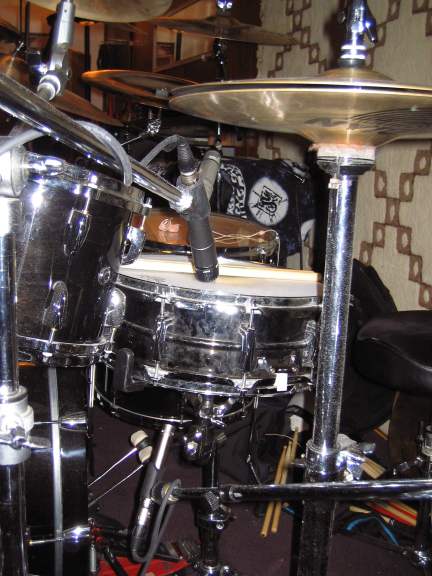
The mics of choice were a Shure SM57 on the top head and a Rodes NT5 on the bottom head. Be sure to flip the phase of the bottom mic.
MP3 - Top head: SM57.
MP3 - Bottom head: NT 5.
Next are the tom mics.
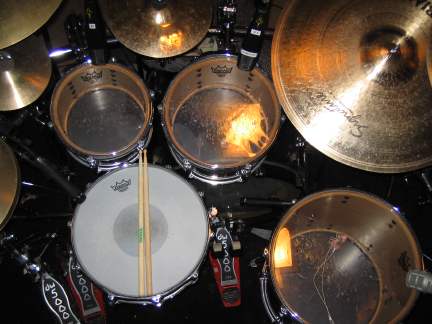
The tried and true toms mics are the Sennheiser 421 (with the roll set to M for music), and a great floor tom mic is the EV RE20 (this was actually a broadcast mic but has a great low end warmth).
The audio file is a stereo sum track of all 3 mics. Notice that there is quite a bit of bleed or leakage from the rest of the kit. This sometimes is quite an undesirable sound that engineers usually use a noise gate to get rid of.
MP3 - Stereo tom track with 2 x 421 and 1 RE20.
Next is the hi hat.
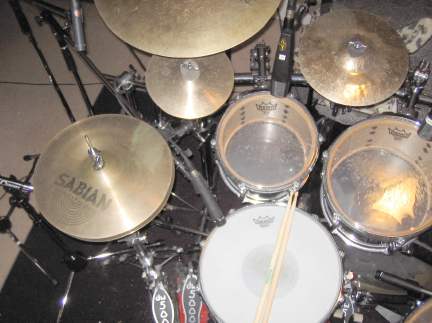
This is a very important part of the kit. It is basically the whole top end of your mix. Make sure to get a great sound by using an excellent condenser mic. The mic of choice was a Neumann KM 184. Notice in the picture that it is placed approximately 8 inches away from the hi hats. The drummer hits them pretty hard, so it was distorting the mic even with a 20dB pad on it. We backed the mic away a little and the sound opened up with a great shimmer.
MP3 - Hi Hat: Neumann KM 184.
Next is the ride cymbal.
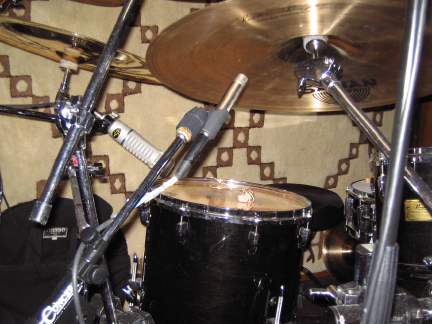
The mic of choice was a Rodes NT5 condenser mic. Notice it is placed under the cymbal. This gave us a very clean, focused bell sound that was uncolored.
MP3 - Ride: NT5.
After this we have the overhead mics. I used 4 mics for this particular setup.
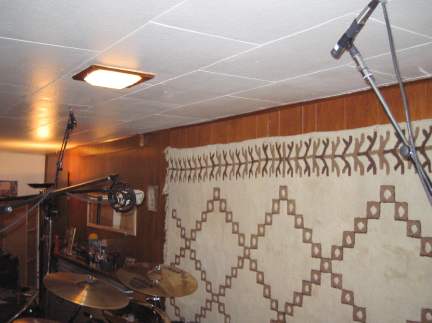
For a very tight drum sound, I used a pair of Neumann TLM 103's in a close angled pattern, directly over the snare drum, approximately 2 feet up. It is hard to see both in the picture, but the other mic is right behind the mic that is visible. This made the kit very tight and picked up the snare and toms exceptionally well. You will notice a pair of Neumann KM184's in a wide spread pattern at each side of the kit. This gave me more of the cymbals, and less drums. These mics will give the kit a certain width in the audio spectrum.
MP3 - Tight overheads: TLM 103 Stereo.
MP3 - Spread overheads: KM184 Stereo.
Last, but not first, was a room mic, which was placed in our laundry room (I forgot to take a picture of this mic). We used an AKG solid tube mic for this purpose.
For this mic, I compressed it very heavily. Some people do a stereo room mic, which is very cool. I have done that also, but this time I wanted a very tight mono compressed sound mixed in with the close miking of the drums. I think this is very subjective, however, if the song was a pop tune, I would change my thinking. In this case, since the drums are very busy, I wanted the sounds to be clean and punchy, thus the mono room sound.
MP3 - Room: AKG Solid Tube.
I think we used a total of 15 microphones on the kit. This is a little excessive, but who cares. Of course, I have left out many things that have not been explained like phasing, placement perfection, pre-amps, etc. I did not want to overwhelm anybody with this column. This was an introduction into what I do. One piece of advice I can give is: before reaching for the EQ on the pre-amp, just move the mic a little bit, this can give a whole new sound that you may be looking for.
I will leave you with a little mp3 file of the whole kit. Please remember this is unmixed, flat, with no EQ, gating or dynamics. Just faders up - rock and roll!
MP3 - Full kit.
May the tone be with you.
David Martone is a guitarist from Vancouver, Canada who has released seven solo CDs which showcase his musical diversity and brilliant guitarmanship.
His 2007 CD is entitled "When The Aliens Come", which features a progressive sound incorporating jazz, rock, fusion and metal influences.
